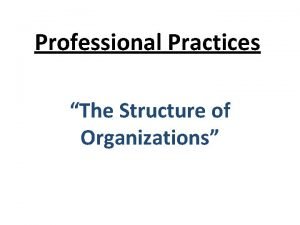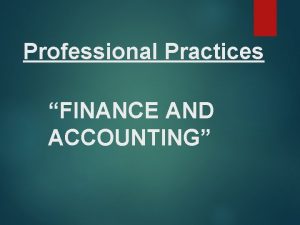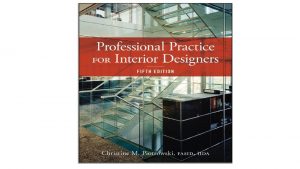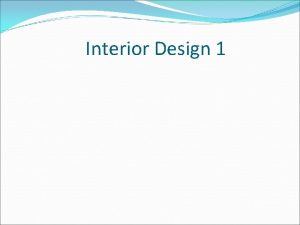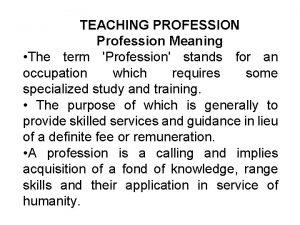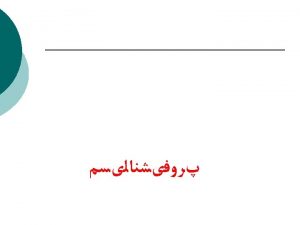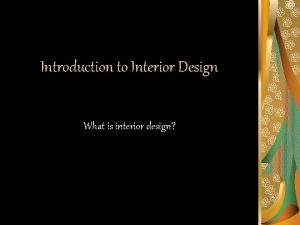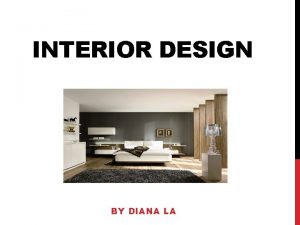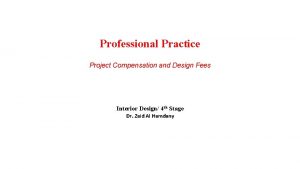Professional Practice Interior Design as a Profession Interior














- Slides: 14

Professional Practice Interior Design as a Profession Interior Design/ 4 th Stage Dr. Zaid Al Hamdany

The stereotype of the interior design profession has been of someone who understands how to use color and can rearrange furniture. This is, as you already know, not the full story of what an interior design professional is or does. Interior design is a complex process and it requires learning much more than the color wheel. The body of knowledge and skills needed by professionals is extensive, and the work of the interior designer—regardless of specialty—is demanding as well as exciting. The professional interior designer’s solutions have to meet functional needs of the client, as well as result in a pleasing environment. The individuals who design interiors must be sure that their designs meet building, fire safety, and accessibility codes. Interior design solutions must also meet sustainable design criteria required by the owners.

WHY STUDY PROFESSIONAL PRACTICE? The profession of interior design is incredibly fascinating. Practitioners have the opportunity to design the interiors of multimillion-dollar houses or help a family have a more pleasing and nurturing home environment. Practitioners also have the opportunity to help a small business or huge corporation provide an interior environment that positively influences their clients and employees and helps the business achieve greater functionality and success. Interior design is much more than a way to express creativity. It is an endeavor that must recognize the importance of ethical conduct. It is about being socially responsible and realizing that, in today’s world, the interior design profession has a global reach. It’s not just about “us” in the United States, it’s about all of “us” on this planet. It is not a hobby; it is not the quick, do-it-yourself situation portrayed on cable TV.

An interior design firm must make a profit—or at least hopes to consistently make a profit. Studying and applying business practices to the management of the firm helps the owner have a greater chance of achieving a profit. If the business owner is to allow his or her company to grow to the extent that he or she would like it to grow, the owner must understand all the aspects of professional practice. As an employee, you will be held accountable for the ongoing success of an interior design firm. You have a responsibility to work productively and bill those hours, or otherwise professionally and effectively complete your job Tasks. You need to have some awareness of the expense it takes to operate a practice so that you do not waste company resources.

DEFINING THE PROFESSION Compared to many other professions, such as teaching and medicine, interior design is a relatively young. The use of the term interior design did not appear in general usage until after World War II, and the profession defined by any term did not really exist much before the 1900 s. Individuals and organizations involved in the interior design profession work tirelessly to help the profession gain recognition in the minds of the public, as well as among practitioners and allied professionals. What constitutes interior design has been debated and nurtured for many decades. Much of the public believes that “people who decorate interiors are interior decorators. ” They often do not understand that there is a difference between decoration and design. Interior design is not the same as decoration. Decoration is the furnishing or adorning a space with fashionable or beautiful things. Decoration, although a valuable and important element of an interior, is not solely concerned with human interaction or human behavior. Interior design is all about human behavior and human interaction.

What is a Profession? A profession is much more than the words in a definition provided by interested groups. According to one dictionary, a profession is “a paid occupation, especially one that involves prolonged training and a formal qualification. As defined by sociologists, a profession is an occupation that is based on theoretical and practical knowledge and training in a particular field. . Professions tend to be credentialed and regulated in relation to certain standards of performance and ethics, which makes them more autonomous and independent than other occupations. ”

A profession includes some central regulatory body to ensure the standard of performance of individual members : 1) A code of conduct. 2) Careful management of knowledge in relation to the expertise which constitutes the basis of the profession’s activities. 3) Control of number , selection, and training of new entrants.

Interior Design Value Most interior designers have, at one time or another, heard this comment from clients. Many professionals are still stumped as to how to respond to this statement. After all these years, professionals and the profession still must combat the undervaluing of interior design services. Unfortunately, many clients still view interior design services as “fun” and “easy” and more “creative” than business. Because they do not see or designers do not communicate how interior design can be of value to them, many question the designer’s suggestions and fees. Too many clients still do not understand why professional interior designers should be compensated for their services or even respected like other professional service providers.

To some degree it might be argued that we ourselves have been responsible for this misconception. Interior designers can be bad businesspeople: giving away design ideas at initial meetings; being unconcerned about costs in running a business; and (frankly) letting the designer’s ego get in the way of solving the client’s problem. These kinds of behavior do not identify good businesspeople. The media contribute to this undervaluing of design as well, too often portraying interior design as easy or frivolous. And with so many people offering design and decorating services—many for free—why should clients value interior design?

Part of the problem arises because interior design is an intangible: it doesn’t exist until after it is done. The only way that the clients can judge the quality of what they hope they will get is by seeing photos or drawings of work that the designer has done for someone else. They can feel a product; they can get comparisons online. Frequently the basis for judging the quality of what they will get from an interior designer is personal aesthetics—and that is very subjective.

Financial Resources A firm makes money by charging design fees for services and perhaps by selling merchandise to clients. Design services have a cost to the company, as well as representing revenue. The biggest cost to the firm for providing design services is the salary of the designer. There are other costs involved in those services. The company has to pay utility bills, buy supplies like pens and ink for the printer, and pay monthly Web fees. These operating expenses are deducted from the revenue that is obtained from clients. Only after the expenses are paid does the firm make a potential profit. And when there is no profit, there are no funds for the owner to provide benefits to employees.

Chronology of the growth of the interior design profession in USA


 Decorativnaia stucaturca
Decorativnaia stucaturca Principles of design in interior design ppt
Principles of design in interior design ppt Professional practice days
Professional practice days Structure of organization in professional practice
Structure of organization in professional practice Finance and accounting in professional practice
Finance and accounting in professional practice Professional nursing practice concepts and perspectives
Professional nursing practice concepts and perspectives What do you mean by professional
What do you mean by professional Model of professional nursing practice regulation
Model of professional nursing practice regulation Focused professional practice evaluation
Focused professional practice evaluation Enhancing professional practice
Enhancing professional practice Danielson 3c look fors
Danielson 3c look fors Tpess training
Tpess training Enhancing professional practice: a framework for teaching
Enhancing professional practice: a framework for teaching Professional practice guidelines moe
Professional practice guidelines moe Political astuteness in nursing
Political astuteness in nursing



